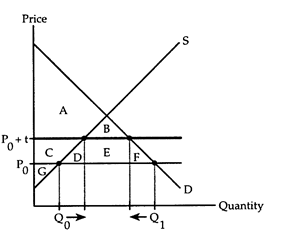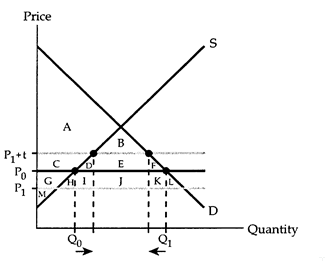As compared to a pollution tax, a command-and-control policy will increase production costs by a ________ amount and increase equilibrium price by a ________ amount.
A. larger; larger
B. larger; smaller
C. smaller; larger
D. smaller; smaller
Answer: A
You might also like to view...
(i) How many videos does Spencer rent each year? How much consumer's surplus does Spencer receive from renting videos? (ii) Blockpopper's starts a "frequent viewers" club. For a membership fee of $35 per year, club members can rent as many videos as they wish at the discounted price of $2 per rental. Should Spencer join the "frequent viewers" club? If yes, how much surplus value would Spencer receive as a club member? If no, what membership fee would Spencer be willing to pay to join the club?
(i) The accompanying diagram shows the effects of a tariff. Initially, the price is P0, domestic firms produce Q0 units, and Q1 - Q0 units are imported from foreign firms. When the tariff is imposed, the price increases to P0 + t.

How does the tariff affect consumers' surplus and producers' surplus? How much tariff revenue is collected by the government? Does imposing the tariff cause the country's social gain to rise or fall?
(ii) The situation in part i is known as the "small country" case-the country has no market power, so its tariff does not affect the world price P0. Now consider the "large country" case shown in the accompanying diagram-in this case, the country has market power, and the tariff (by reducing the demand for imports) causes the world price to fall from P0 to P1. So after the tariff is imposed, the domestic price is P1 + t.

How does the tariff affect consumers' surplus and producers' surplus in this situation? How much tariff revenue is collected by the government? When a "large country" imposes a tariff, will its social gain rise or fall?
Of the following, the one that appears in the current account of the balance of payments is
A) an Italian investor's purchase of IBM stock. B) income earned by U.S. subsidiaries of Barclay's Bank of London. C) a loan by a Swiss bank to an American corporation. D) a purchase of a British Treasury bond by the Fed.
Which of the following is NOT true about the supply of labor to the firm in a competitive labor market?
A) It is horizontal. B) It is perfectly elastic. C) It is equal to the marginal expenditure curve. D) It is upward sloping.
Which of the following provides the fuel for growth and
What will be an ideal response?